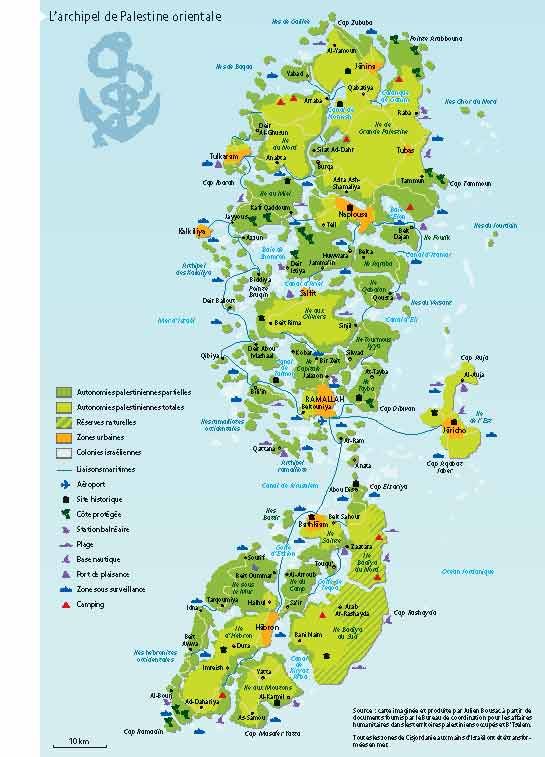The Eastern Palestinian Archipelago
 Source: Imaginary map produced by Julien Bousac from documents provided by OCHA and B’Tselem.
Source: Imaginary map produced by Julien Bousac from documents provided by OCHA and B’Tselem.
Apologies for the poor quality of the reproduction.
BUT it is an inspired representation.
For the record: according to the French key, the dark green areas are ones of partial Palestinian autonomy, the light green total auttonomy, hatched green areas are natural reeserves, orange areas are urban zones, and blue are Israeli settlements (the French word ‘colonie’ says it so much better!).
See a better quality web version here, where yu will also find some comments by the map’s originator:
“Maybe posting the full map would help to take it for what it is, i.e. an illustration of the West Bank’s ongoing fragmentation based on the (originally temporary) A/B/C zoning which came out of the Oslo process, still valid until now. To make things clear, areas ‘under water’ strictly reflect C zones, plus the East Jerusalem area, i.e. areas that have officially remained under full Israeli control and occupation following the Agreements. These include all Israeli settlements and outposts as well as Palestinian populated areas.”
Mr Boussac took advantage of the resulting archipelago effect “to use typical tourist maps codes (mainly icons) to sharpen the contrast between the fantasies raised by seemingly paradise-like islands and the Palestinian Territories grim reality.” The map does have a strong vacationy vibe to it – but whether that is because of the archipelago-shaped subject matter, or due to the cheerful colour scheme is a matter for debate.
Those colours, incidentally, denote urban areas (orange), nature reserves (shaded), zones of partial autonomy (dark green) and of total autonomy (light green). Totally fanciful are of course the dotted lines symbolising shipping links, the palm trees signifying protected beachland, and the purple symbols representing various aspects of seaside pleasure. The blue icon, labelled Zone sous surveillance (‘Zone under surveillance’) has some bearing on reality, as the locations of the warships match those of permanent Israeli checkpoints.
Some of the paradisiacally named islands include Ile au Miel (Honey Island), Ile aux Oliviers (Isle of the Olive Trees), Ile Sainte (Holy Island) and Ile aux Moutons (Sheep Island), although the naming of Ile sous le Mur (Island beneath the Wall) constitutes a relapse into the grimness of the area’s reality.
